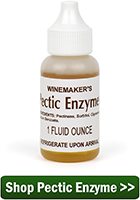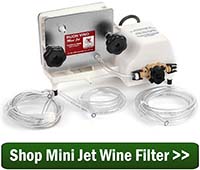 I have made delicious peach wine in the past, but last year, the peaches were ripe when I was out of town. My son cleaned, sliced and froze them in freezer bags til I could get home. It’s been 10 mos. and the wine refuses to clear – I’ve tried everything. Was pretty sure I had read you could freeze fruit til ready to use, but maybe not? That’s the only thing I remember doing differently…”Blue Moon” Peach Wine anyone?
I have made delicious peach wine in the past, but last year, the peaches were ripe when I was out of town. My son cleaned, sliced and froze them in freezer bags til I could get home. It’s been 10 mos. and the wine refuses to clear – I’ve tried everything. Was pretty sure I had read you could freeze fruit til ready to use, but maybe not? That’s the only thing I remember doing differently…”Blue Moon” Peach Wine anyone?
Name: Carol
State: Maryland
—–
Hello Carol,
Freezing the peaches would not have anything to do with the wine being cloudy. I think this has more to do with using pectic enzyme. Freezing the fruit will only help to break down the fiber allowing you to get more flavor from the peaches. Freezing the fruit is something we recommend doing all the time. So even though this is the only apparent difference from other times you’ve made this wine, this is not the cause of your peach wine being cloudy.
Assuming that the fermentation went along just fine, the number one reason for a peach wine to be cloudy is because of something called a pectin haze. Peaches have a considerable amount of pectin in them when compared to other winemaking fruit. Pectin is the gel that holds the fruit’s fiber together. It has a milky appearance to it when removed from the fruit.
With most fruit the pectin is broken down and cleared during the fermentation. The wine yeast produce enzymes that help to do this. Most fruit wine recipes will also call for pectic enzymes as additional insurance to see to it that all the pectin cells are broken down. You can read more about this in a previous blog post, Why Do Some Wine Recipes Call For Pectic Enzyme? When using pectic enzyme the pectin cells are broken down into a substance that is clear and watery.
If all the pectin cells are not broken down then they add to the cloudy appearance of the wine. In the case of peaches, sometimes not all the pectin gets broken down. Sometimes this is caused by a stressed wine yeast, but it can also be caused by using pectic enzyme that is old or not using enough pectic enzyme. If any fruit is gong to expose this error it would be the peach wine due to its abundance of pectin cells. Other fruits high in pectin are plums, strawberries and persimmons.
It is important to understand that a pectin haze can not be cleared out with fining agents such a bentonite, isinglass or Sparkolloid. This is because these types of clarifiers are primarily used to clear out particles. Pectin is not a particle, but rather, something that is molecularity bound to the liquid. No fining agent can touch it. It needs to be broken down through enzymatic activity. That is why using pectic enzyme is so important in these situations.
You can try adding more pectic enzyme to the wine, but it may take a while for the full reaction to take place. The enzymes work much more slowly after the fermentation when the activity is not present. Patience may be required on your part. It could even take several months.
 If you would like to verify that it is a pectin haze you are dealing with you can take a small sample of the wine and add extreme doses of the pectic enzyme to it to see if it will clear the wine: say, a teaspoon to 4 oz. to 8 oz. of wine. You should see a reaction with in days, if not hours, at this dosage.
If you would like to verify that it is a pectin haze you are dealing with you can take a small sample of the wine and add extreme doses of the pectic enzyme to it to see if it will clear the wine: say, a teaspoon to 4 oz. to 8 oz. of wine. You should see a reaction with in days, if not hours, at this dosage.
Hope this information about using pectic enzyme helps you out.
Happy Winemaking!

I know you don’t sell it but I have excellent success clarifying my peach wine by using a product called "Super-Kleer". They do recommend letting it sit for 24 hours after use.
Bob
Ed & Carol, I too have a summer peach wine working and a slow, stubborn one to clear. I took a quart sample and chilled it to see if the problem was suspended yeast. After a week, still hazy, milky looking, although a bit better as some yeast did drop out. I racked over onto a 2nd dosage of PE, stirred some, and after 2 weeks its looking much better. Here’s hoping another 2-3 weeks and its in the bottles. Hope this helps, CW
Is there any way to dilute benzoic acid, soduim benzonat and or potassium sorbate found in fruit juices? Example.. if such food perservative were in a gal. of juice with fruit and that gal. was going to be used for a 3 or 5 gal must, would the dilution be enough to keep a (2) packet of yeast alive through fermentation? Is there another way around to use the juice or should I just abanden this wine project?
Thanking you for your advice. Mel
Mel, there is no specific way to know how much dilution is needed to allow a fermentation to occur. This is because the mfgs. do not have to tell you exactly how much they put in of any of these ingredients. The only way to get an answer to the question is to perform some bench tests on the specific brand you are interested in.
Will Pectic enzyme clear red wine ?
Gorden, actually pectic enzyme helps aid in the clarification of most homemade wine, both red and white
Why Do Wine Recipes Call For Pectic Enzyme
http://www.eckraus.com/blog/why-do-wine-recipes-call-for-pectic-enzyme
SORRY, posted my old email address — question was however, I also made peach wine (for the first time) and it is very milky/hazy. It smells beautiful but definitely does not look beautiful. I would like to try and add some pectic enzyme — how much would you add per gallon for clarifying?
DRIA
Andrea, if the fermentation is complete and the wine is not clearing, a pectin haze may be the problem. To clear a pectin haze using our liquid pectin enzyme, you will want to add a double dose if did not add pectic enzyme already and a single dose it you have already added it. The dosage is 1/8 teaspoon per gallon of wine. The article posted below will discuss this in more detail.
Clearing a Pectin Haze
http://www.eckraus.com/blog/clear-pectin-haze-pectic-enzyme
I made a 6 gallon batch of peach wine using fresh fruit and the wine would not clear after 3 months. I used bentonite on the first racking after primary fermentation. After a couple of weeks the wine did not show any signs of clearing. I racked the wine off the sediment and wait 3 months without any clearing and even used your recommendation for testing if pectic haze was the problem. No results. The sample of wine did not clear. I had almost given up when I read a comment on your article about cloudy peach wine where the person used a 2-pouch(Kieselsol/Chitosan) Super Kleer KC fining product and it cleared his peach wine. I happened to have the product tried it. As soon as I poured in the second pouch, it started working. After two days I racked the wine off the sediment and the wine was so clear you could read a book through it. This product works.
Had not heard Freezing recommended, just happens to be great storage before getting to the wine-making especially when collecting enough fruit for a 12 gallon run. Results in GREAT flavors especially in my Dewberry/Blackberry combo. Assistant is hooked on idea of ‘Ice Wine’ and is convinced that our freezing results in Ice Wine despite explaining what the grapes experienced while still on the vine and fact that grapes frozen 1+ years do not result in Ice Wine flavor.
Any recommendation regarding amount of time (min/max) to freeze fruits for best results??
Jim, As it sounds like you already know, that you are actually attempting to make is an icebox wine not an ice wine. The difference being, you are using artificial cold to freeze the grapes as opposed to leaving them on the vine and waiting for Mother Nature to do the freezing for you. As far as how long to freeze the there really isn’t a specific time frame. If you do want to freeze the grapes, say six months or more, you may want to consider packing the fruit in sugar syrup. This will help to eliminate any negative effects from freezer-burn. Just like it sounds, you use just enough sugar syrup to cover/submerge the fruit before freezing.
How To Make Ice Wine
https://blog.eckraus.com/how-do-you-make-ice-wine
Hello friends,
I have a question that still has no answer from you. Your contact link became complicated, looks to me you start being afraid of robots or visitors from Mars, so many stupid questions. Or maybe the world we live in is fool of stupid S and their number is growing,.. I believe to this. But about my question….
I made cashew wine in 5 gallon buckets. First 2 buckets finished with SG – 0.095 and I call it DRY WINE. Other buckets finished with SG- 1.000 and I call it SEMI-DRY WINE.
Last buckets finished with SG- 1.005 and I call it as SEMI-SWEET WINE. But I need your opinion in how to separate those categories. Please email me to my email. Thank you
Walter, we did send you an email on 6-6-18 regarding your question. Unfortunately, using a wine hydrometer is not an accurate way to determine the sweetness level of the wine, The following article will discuss this in more detail.
Using A Hydrometer To Adjust Sweetness Level Of Wine.
http://eckraus.com/wine-homebrew-blog/using-a-hydrometer-to-adjust-a-wines-sweetness/
sometimes the haze in peach wines is a protein haze. I found that using bentonite in the fermentation eliminate this problem post fermentation . also works with pear wines
I made banana and mango wine and both of them are cloudy, I tried Bentonite and they are still cloudy. Ed can you tell me what else to do to clear my wine?
Thank you
Emel, First, have your checked to see if the fermentation is complete? The wine will not begin to clear until the fermentation is complete. Have your checked for a pectin haze as the article talks about? If it is not a pectin have, there are a couple other reasons that can cause a cloudy wine as explained in the article posted below.
Four Reasons For A Cloudy Wine
https://blog.eckraus.com/cloudy-wine
Thank Ed I did not do the pectin test I would try that.